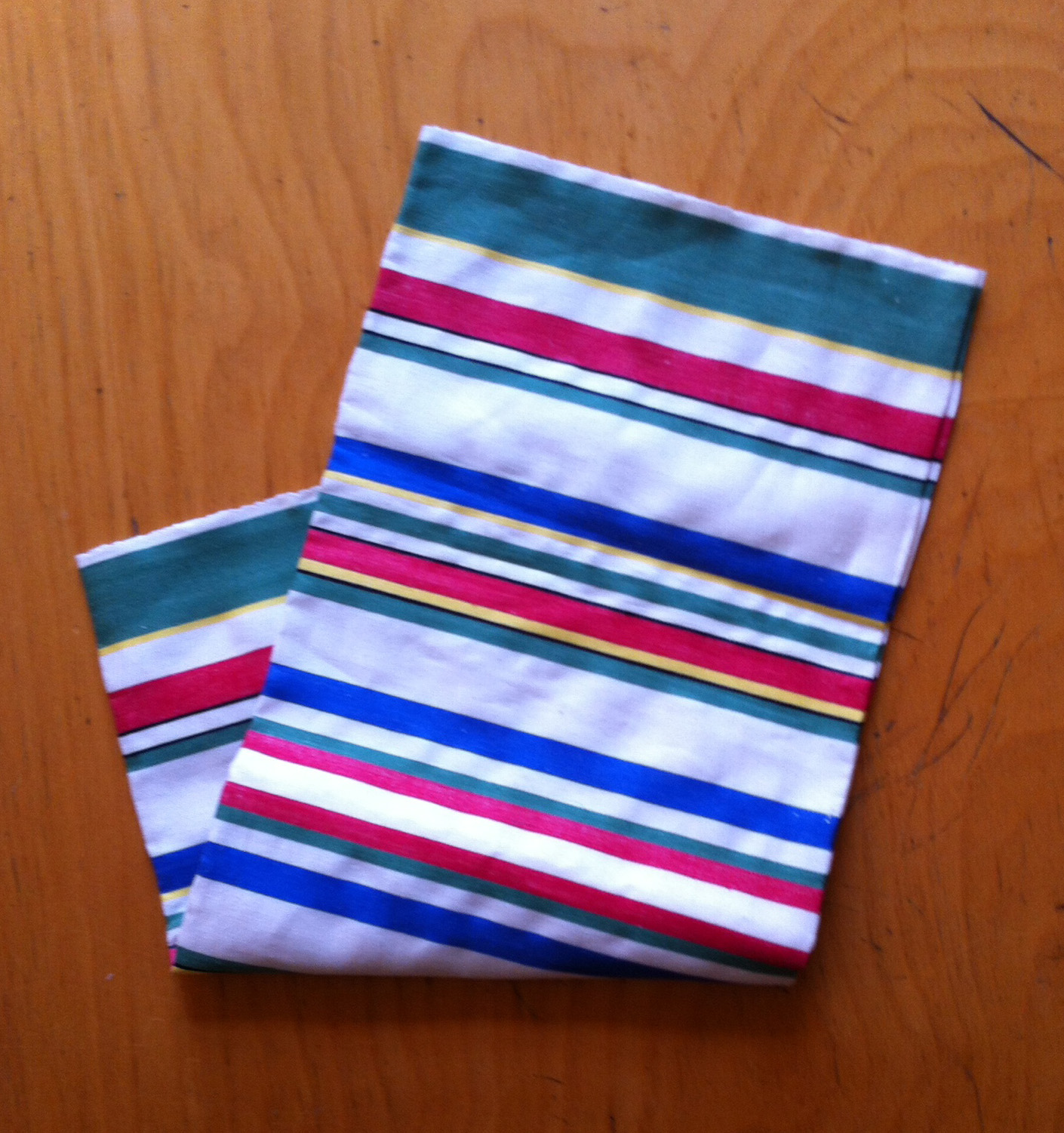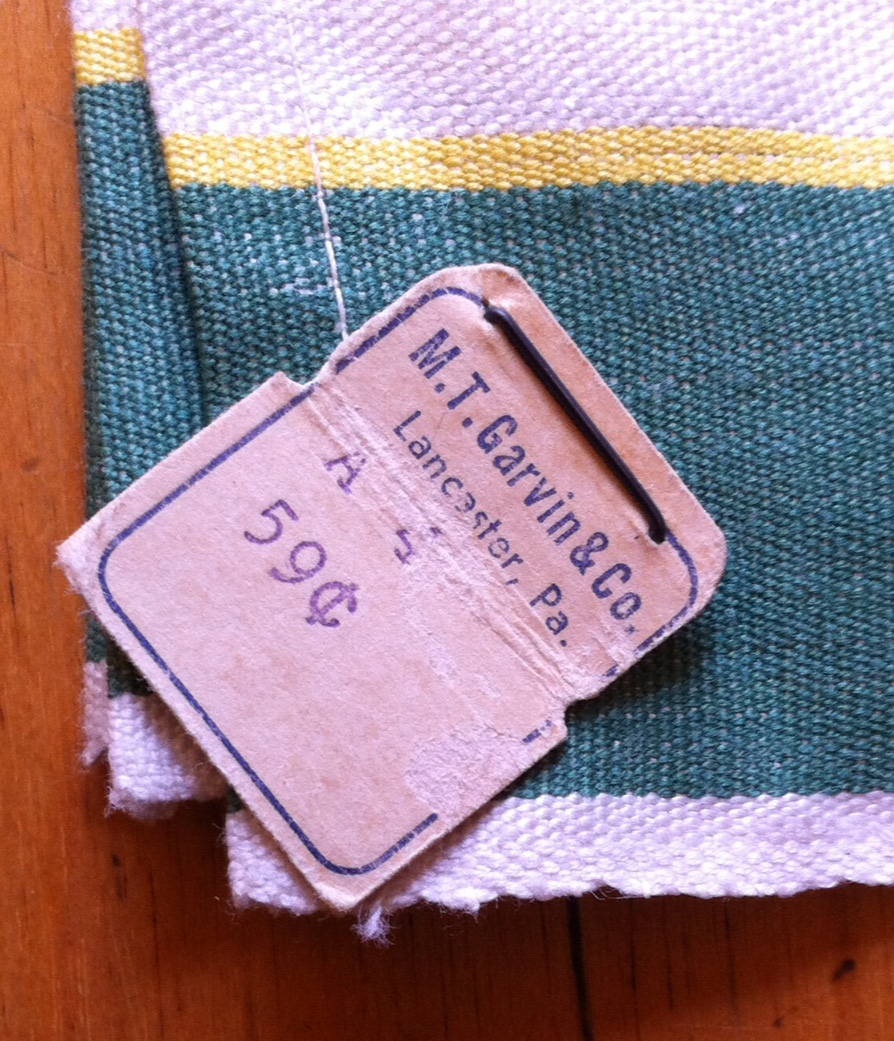
For all of today's photos, click to enlarge
I'm a sucker for retro stripe patterns. So when I recently saw this vintage linen tea towel at a flea market, I was enticed, even though I don't really have any need or use for a tea towel. What sealed the deal was the original price tag still pinned to a corner of the towel — I'm a sucker for that kind of thing as well. I bought the towel, along with another one (which we'll get to in a minute), for $7.
I was curious about the shop listed on the price tag — Hager & Bro. Inc., of Lancaster, Pennsylvania — so I Googled it. Turns out there's a lot to learn.
Hager & Bro. (sometimes listed as Hager Brothers) was a department store run by the Hager family, which has deep roots in the Lancaster area. The family's retail history in Lancaster dates back to the early 1820s (different sources give conflicting accounts of the exact year), when Christopher Hager purchased a plot of land on the corner West King and Market Streets and established a mercantile business there. Here's an eBay listing for a pamphlet showing the business's clothing prices in 1889. (Some really nice typography and wording in there, incidentally — definitely worth a closer look.)
That same property at the corner of West King and Market later became the site of the Hager Building, which was built in 1910 and housed the family's department store:

According to this item in the Nov. 19, 1921 issue of the trade journal Dry Goods Economist (now there's a publication name!), Hager & Bro. was at that time "the oldest department store in the United States continuously operated by the same family." The item also mentions Christopher Hager's savvy business maneuvers, such as the time "he purchased an entire cargo of coffee that had become drenched by not damaged."
Hager's was acquired by another department store, Watt & Shand, in 1968 and closed in 1977, but the building remains. It's now occupied by an assortment of shops and condominiums and is listed on the National Register of Historic Places. There's also a box of Hager's-related artifacts at the Lancaster Historical Society.
It's not clear exactly when my tea towel was available for sale at Hager's, although the design of the towel and the tag both seem 1960s-ish to me. I love that the tag is pinned on (as opposed to being stapled or some other format), which absolutely screams "old-school dry goods shop."
But wait — there's more. When I told the flea market vendor that I was interested in the towel, she said, "Here, do you want this one, too?" She then produced this towel, which I hadn't initially seen because it was hidden underneath some other items:

Frankly, I didn't like this towel as much as the first one — the stripe pattern seemed a little too busy, too showy. But then I thought to myself, "Does this one have a Lancaster price tag too?" Yes — but not from Hager's:

How did one flea market vendor end up with two such similar towels that were originally sold at two different shops in the same city? Bizarre.
Unfortunately, there isn't as much readily available information about M.T. Garvin & Co. as there is about Hager & Bro., but I did find a few pieces of the puzzle. Milton T. Garvin was a prominent Lancastarian who helped establish the city's Unitarian Universalist church. He had a department store (here's an obituary for someone who once worked there as a buyer), which presumably competed with Hager's. According to this 1918 listing of oleomargarine licenses (!), Garvin's was located at 29-37 East King St., just a few blocks from Hager's.
It's not clear to me when Garvin's closed, but it was still going strong in 1970, as seen in this 1970 postcard that I found on eBay. You can see "Garvin & Co." on the side of the building and a big "G" logo over what is presumably the main entrance:

Another thing I found on eBay was this Garvin's promotional ruler, which lists three different slogans: "Where the Thrifty of Lancaster Shop and Save"; "Lancaster's Big Cash Department Store"; and "Where Boys and Girls, Mother and Dad Are Always Welcome":

There's something about that broad range of sloganeering that I find very amusing.
One final thought: If you look again at the two price tags, you'll see that one of them is marked "11-A-3" and the other "A 4":

That seems like too big much of a coincidence to be random. Anyone know what those "A"-based designations were for? (Update: Reader John Vahey has found some information explaining that the alpha-numeric designations on the price tags may have been part of a system for dry goods stock numbers.)












